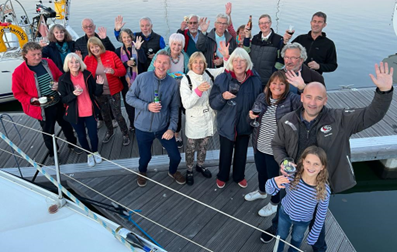- This topic is empty.
-
AuthorPosts
-
November 7, 2007 at 5:55 pm #6121
Anonymous
Hi, I am considering adding AIS to my C120 plotter and radar. I would welcome any usefull tips or recomendations. Has anyone tried the Raymarine AIS?
Regards,
John
LoblollyNovember 8, 2007 at 6:02 pm #7441Anonymous
John
I don’t know anything about the Raymarine AIS but can recommend the NASA ‘engine’. It costs around £110 and works fine. It needs a VHF aerial and 12V inputs and provides the standard AIS NMEA output at 38.4KB. I use it into a laptop computer but I expect it will drive into the C120 using NMEA without problem (once you have sorted out which wires/connectors to use!).
I rate AIS highly. On both channel crossings this summer when the ‘collision’ alarm sounded I was able to identify the hazard by name and call them up on VHF. In one case, the freighter executed a 40 degree turn to pass astern of me – he clearly hadn’t seen me (or was playing ‘chicken’ but was exposed to the world on channel 16)!
Get one – it’s well worth the investment in open water. However, you will need to turn off the collision alarm in the Solent otherwise it will sound constantly!
Roger
November 8, 2007 at 10:11 pm #7442Anonymous
Hi Roger, Thanks for your response. I agree with you. I have used AIS on two other boats and decided at once that it was a ‘must have’. The NASA engine sounds good value.
Regards
John
LoblollyNovember 10, 2007 at 5:18 pm #7443Anonymous
I’ve had an Easy AIS attached to an E80 for about a year, and used it a large amount; recently I changed to a Comar AIS.
A couple of points for you to consider:
Firstly physical connection. The E80 only has one NMEA input, and the speed of that input needs to be set to 4800 (normal NMEA) or 38400 (AIS speed). One input is fine unless you want to connect more than one device, and I had a Raymarine course computer autopilot which outputs head from the compass 10 times a second on NMEA. This is useful into the E80 because it stabilises the radar overlay. So if you want this stablized picture and AIS you need to connect two NMEA devices which operate a different speeds to one input. To accomplish this you will need an NMEA multiplexor that can take multiple input speeds and combine them into one output stream at 38400 into the E80. Shimodul (and probably others) make a device to do this and it works! (BTW the multiplexor joins 4 inputs so it also allows an NMEA input to the E80 from the DSC VHF which allows me to plot DSC position requests – but that is another story).
The second point is the “type” of AIS receiver. The AIS radio part uses two different frequencies, (if one frequency gets blocked the other still might work). Each AIS transmitter alternates its transmissions between the two frequencies.
Lower cost AIS receivers listen to only one frequency at a time. I had an EasyAIS, and I worked out it listened on channel A for about 4 mins 30 seconds, then it changed to channel B. So this meant I was getting half the AIS messages a ship sent. A consequence of this is that targets made larger “jumps” across the screen – and therefore CPA/TCPA calculations where less accurate. It look longer to see if a ship was turning or accelerating.
This might not matter to you, and it will depend how much you come to use the AIS.
One small software problem I’ve noticed with the E80 is that some anchored targets dont appear, or appear and disappear. This turns out to be because anchored targets only send AIS every 3 minutes, and with the channel changing of the EasyAIS you can see that it is possible for the receiver to be listening on the wrong frequency. Raymarine say that they might fix this one day.
Anyway, having used it for a long time I can give you lots of examples of “operational success” – I’ve often seen ships in the channel lanes altering speed/course to pass ahead/astern of me. In the Solent I can tell if I can get across to Mother bank and stay clear the VLCC coming in between the forts, or if I should tack to avoid the dredger coming out of the North Channel. And even for getting the MMSI of the odd ship on a dark night to DSC him and be sure he sees me.
My advice is to get an AIS, a consider if spending a little more on a dual channel receiver might be worth it.
November 11, 2007 at 11:56 am #7444Anonymous
Thanks John, your reply was very usefull. It will help me ask a few more questions when I am getting a quote.
Regards
John
LoblollyJanuary 20, 2008 at 8:47 pm #7479Anonymous
Hi,
I am wondering whether anybody has tried or has experience of the Simrad A150 AIS Transceiver and if so What is thought of it.
SV., Pickled Tink,
Kos Island, Hellas -
AuthorPosts
- You must be logged in to reply to this topic.




